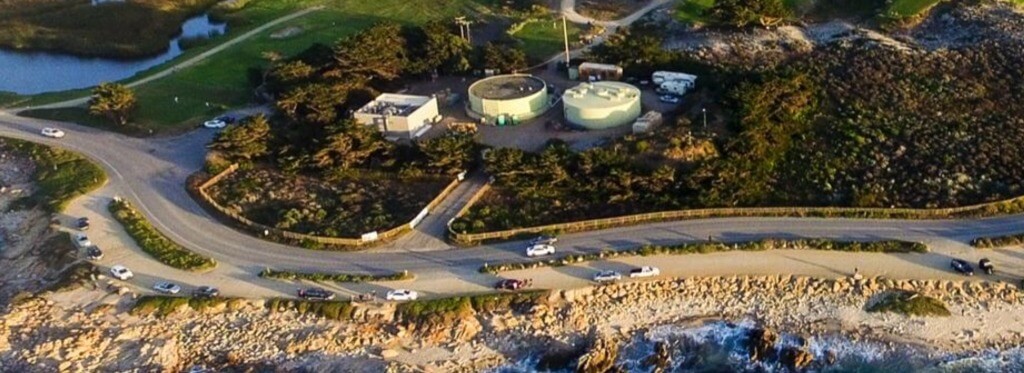Pacific Grove’s Local Water Project

Even the city of Pacific Grove got into the act. We took matters into our own hands several years ago to build the Pacific Grove Local Water Project (LWP) to provide water for the municipal golf course and El Carmelo Cemetery. The result is that we are among the few Peninsula communities who have water for use though, because of state restrictions on the Peninsula, not on new buildings – yet.
Fortunately, we had the perfect property available for the recycling plant so that we didn’t have to pay for expensive infrastructure. Right next to the golf course sat the city’s old and retired sewage treatment plant. It turned out that we could clean it up, fix a few things, put in some new equipment, paint the storage tanks, and convert them to both non-potable water storage and a small office.
The city worked with PERC Water to design, build, and operate the plant for the city. For several years the city was involved with Environmental Impact Reports and negotiations with the State Water Resources Control Board (SWRCB), the Monterey Peninsula Water Management District (MPWMD), and Monterey One Water (M1W) to determine how it would work and the impact it might have on the regional sewage system.
Originally there was some concern on the part of M1W that taking water out of the system at the Pacific Grove end could negatively impact the sewage pump stations further along in the system. That was all worked out and the council members of the time held a ground breaking ceremony in December of 2016. By December of 2017 the plant was completed and we had a ribbon cutting ceremony.
Fortunately, the voters of California had passed a bond measure which raised $7.5 billion to fund water projects. Because the state water board found the PG project compelling and of interest as an example of what other areas could do, we received $7.7 million from the state. It came in the form of a $5.2 million 1% interest state loan and a $2.5 million grant; with the grant applied once the city pays off the $5.2 million – thereby effectively paying off the rest of the loan at that time.
A major benefit was that the recycled water would be much less expensive than potable water. A golf course uses a lot of water, and the 125 or so acre feet per year (afy) of water we used then was priced at a very high tier rate of $7,000 per acre foot. The cost of the recycled water was half that at $3,500. In addition, the city contracted with CourseCo – the city’s golf course management company – for them to pay an amount equal to the city’s annual interest payment to the state. The plant also has a system where builders can take on water to use in construction. Very convoluted, I know, but it works and the city will greatly benefit for decades to come.
But it was also realized that we were, in effect, decreasing the amount of water Cal Am was having to take from the river. The city thought it should get some credit for that water, with some of it available for sale to city residents and businesses. After all, some of our residents had been on the city’s water wait list for up to ten years, and many of our businesses need more water to improve their buildings – or even to build apartments, condos, or hotel rooms.
Getting those water credits wasn’t easy though, because the Peninsula has been under a Cease and Desist order since 2009, and the state would have preferred to leave that water in the river. The city’s reasoning was that, if we took on debt to create recycled water and freed up river water, we should be able to get some benefit for that expense and effort. We have to also remember that the city, which used 1,477 afy in 2009; had already reduced its water use by almost 22% to 1,158 afy by 2017. So, in effect, the city had helped Cal Am reduce the amount of excess water it takes from the Carmel River by quite a bit already! City Manager Ben Harvey, City Attorney David Laredo – and even Water District General Manager Dave Stoldt – argued with the state on the city’s behalf.
In 2019 the SWRCB finally sent the city a letter agreeing with the city’s position; though they imposed two conditions. Those restrictions required that any property owner who wanted to buy water had to already have a water meter (which matched the conditions of the CDO), and that some of the water freed up went to others. This includes 13 AFY left in the river, and 9 AF going to the water district (though we need to remember that PG is also part of the district and eligible for some of that water).
The city is allowed to use just under 48 afy and the council had already proactively determined to charge already established market prices for that water. Though some complained that price was excessive, much of the water has already been requested and is either pending distribution or building permits are in process; leaving only about 11 acre feet still available but, again, only for properties which already have water meters. As a result, our city could earn almost $6.4 million from the sale of water – which can be used to pay bills and provide services.
Not too bad for a little city of just over 15,000 people on the Pacific coast, huh?